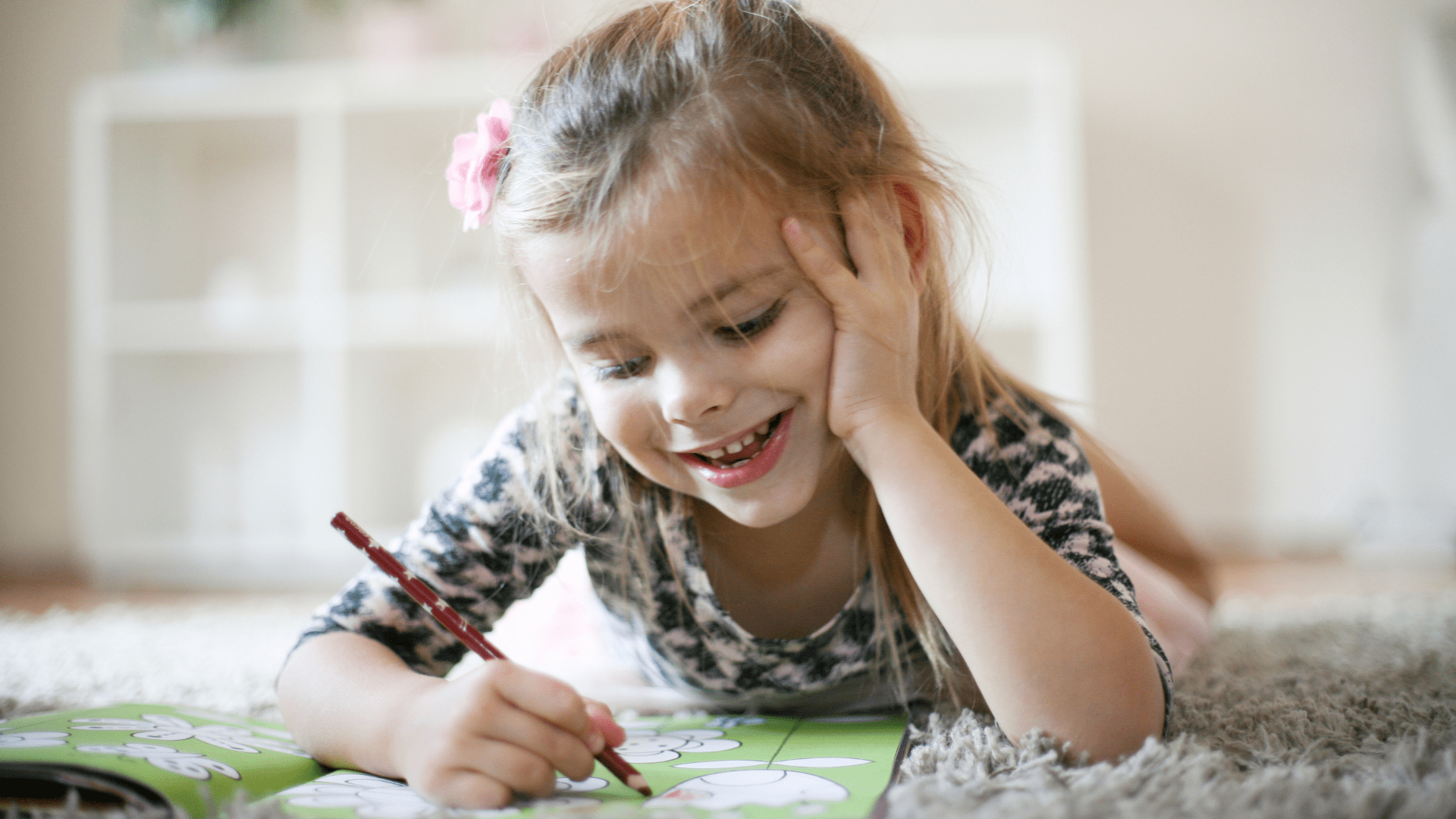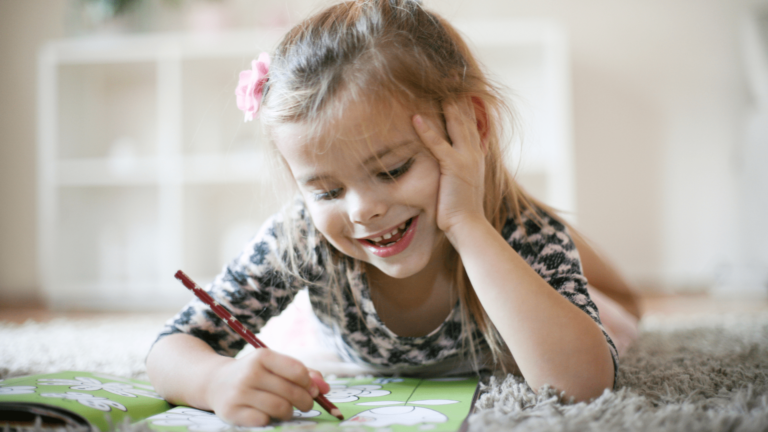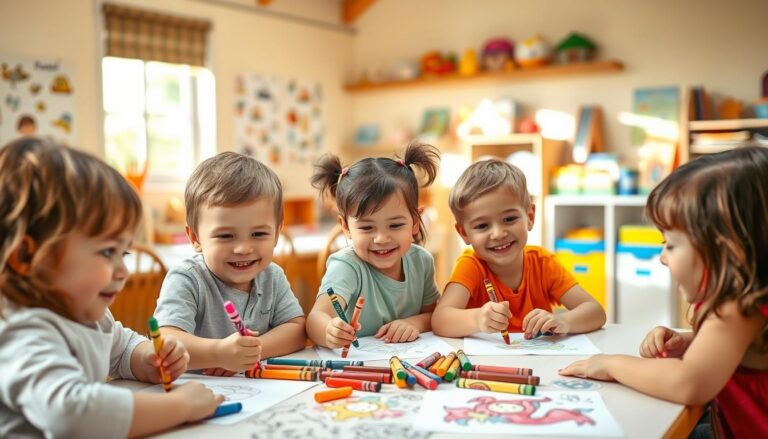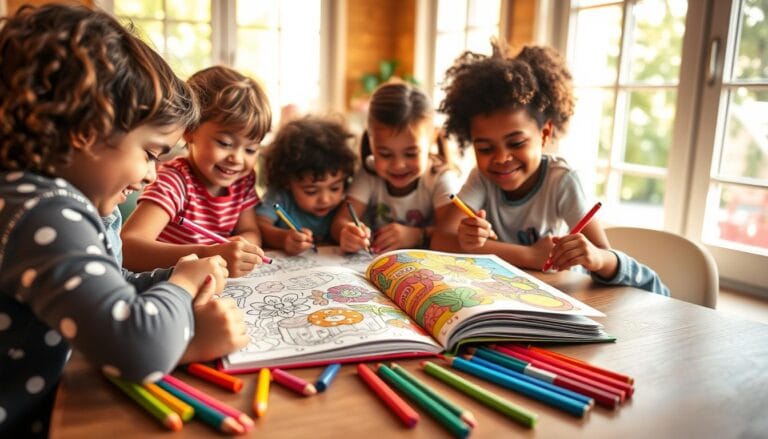1 The Benefits of Coloring for Kids’ Focus and Creativity
How Coloring Boosts Kids’ Focus and Sparks Creativity
The Benefits of Coloring for Kids’ Focus and Creativity,Looking for a simple yet powerful way to enhance your child’s focus and creativity? Coloring—a classic childhood activity—offers more than just fun. It can play a meaningful role in nurturing their growth and development.

Coloring is more than just a fun activity. It’s a way for kids to develop their fine motor skills, hand-eye coordination, and self-expression. As they try out different colors and techniques, they grow their creativity and confidence.
Key Takeaways
- Coloring enhances kids’ creativity and self-expression.
- It improves their fine motor skills and hand-eye coordination.
- Coloring activities can boost kids’ confidence and focus.
- It’s a fun and engaging way to support cognitive development.
- Coloring can be a valuable tool for kids’ overall growth.
The Benefits of Coloring for Kids’ Focus and Creativity: The Science Behind Brain Development
Research shows that coloring is key in shaping young minds. It stimulates different brain areas. This activity is more than just fun for kids; it’s a complex process that helps their brains grow.
How Coloring Activates Different Brain Regions
When kids color, they use many parts of their brain at once. This is important for learning new skills.
Fine Motor Skills Development
Coloring boosts fine motor skills. Kids learn to hold crayons and move them in the picture. This improves their hand-eye coordination and dexterity.
Visual Processing Enhancement
Coloring also sharpens visual skills. Kids learn to tell colors and shapes apart. This helps them better understand visual information.
The Neurological Connection Between Hand Movements and Cognitive Function
The act of coloring links hand movements to brain function. As kids color, their brain’s memory, attention, and spatial skills get a boost. This improves their thinking abilities.
Knowing how coloring affects the brain helps parents and teachers. They can see the value in making coloring a part of a child’s day. This supports their brain growth and learning.
How Coloring Improves Focus and Creativity in Kids
Coloring is more than just a hobby. It’s a way for kids to improve their focus and creativity. By coloring, they can better concentrate and express their artistic side.
Building Concentration Through Sustained Attention
Coloring helps kids focus on one thing for a long time. This improves their concentration in several ways:
- Staying Within Lines: Keeping to the lines of a coloring page sharpens their fine motor skills and hand-eye coordination. It requires them to pay close attention and be precise.
- Completing Complex Patterns: As they get better, they can handle more complex designs. These need even more focus and attention to detail.
Fostering Creative Expression and Decision Making
Coloring is not just about following the lines. It’s a chance for kids to show their creativity. Through coloring, they make choices that help them grow creatively.
- Color Selection and Artistic Choices: Kids learn to pick colors and make artistic decisions. This helps them develop their own style and creative voice.
- Developing Personal Style: Trying out different colors and techniques helps them find their unique artistic style. This style shows their personality and creativity.
Coloring activities can greatly benefit your child’s focus, creativity, and development. Encourage them to try various coloring techniques and materials. This will help them get the most out of coloring.
Age-Appropriate Coloring Activities for Different Developmental Stages
The benefits of coloring for kids are huge when activities match their age and stage. Coloring is more than fun; it boosts various skills in children as they grow.
Toddlers (Ages 1-3): Building Motor Skills
For toddlers, coloring helps build motor skills. They should use simple, big shapes and finger paints.
Large, Simple Shapes and Finger Painting
Toddlers can explore colors and textures with big crayons or finger paints. This improves their hand-eye coordination and fine motor skills.
Preschoolers (Ages 3-5): Developing Precision
Preschoolers should focus on precision and control in coloring.
Basic Patterns and Themed Coloring Pages
Introducing basic patterns like lines and circles helps improve fine motor skills. Themed coloring pages also spark their imagination.
School-Age Children (Ages 6-12): Advancing Artistic Skills
For school-age kids, coloring gets more complex, advancing their artistic skills.
Complex Designs and Independent Projects
Working on complex designs and independent projects boosts creativity and problem-solving skills.
Here’s a summary of age-appropriate coloring activities and their benefits:
| Age Group | Coloring Activities | Skills Developed |
|---|---|---|
| Toddlers (1-3) | Large shapes, finger painting | Motor skills, hand-eye coordination |
| Preschoolers (3-5) | Basic patterns, themed coloring | Precision, fine motor skills, imagination |
| School-Age (6-12) | Complex designs, independent projects | Artistic skills, creativity, decision-making |
Setting Up the Perfect Coloring Environment for Maximum Focus
To get the most out of coloring for your child, the right setup is key. A tidy, quiet spot helps them focus better.
Creating a Distraction-Free Space
A clean area for coloring helps your child stay focused. Make sure it’s away from busy spots and screens.
Lighting and Seating Considerations
Good lighting is vital; natural light is best, but a bright, steady lamp works too. Also, comfy seating matters. Pick a chair and table that fit your child well.
Organizing Supplies for Easy Access
Keep coloring stuff within reach to avoid distractions. Use bins or baskets for crayons, markers, and paper.
Establishing a Routine for Coloring Sessions
Having a regular coloring time helps your child get into a creative habit. Being consistent is important.
Optimal Duration for Different Age Groups
Coloring time varies with age. Young kids start with 10-15 minutes, growing to longer as they can focus more.

Choosing the Right Coloring Materials for Your Child’s Age and Skill Level
Choosing the right coloring materials is key to boosting your child’s creativity. Coloring helps improve their fine motor skills, creativity, and focus. The right tools can greatly impact their artistic growth and brain development.
Types of Coloring Tools: Crayons, Markers, Colored Pencils
Each coloring tool has its own benefits for kids. Crayons are perfect for toddlers because they’re easy to hold. Markersare great for older kids who have better hand control. Colored pencils are best for the most skilled children, offering detailed coloring.
Safety and Durability Factors
When picking coloring tools, think about safety and how long they last. Look for non-toxic materials and washable options for easy clean-up. Tools that can handle rough use are also important.
- Choose crayons made from natural wax or soy.
- Go for markers with safety caps to avoid choking hazards.
- Opt for colored pencils with strong leads to prevent breakage.
Selecting Appropriate Coloring Books and Printables
The type of coloring books and printables you choose matters a lot. You can pick ones that teach or ones that are just for fun, depending on what your child needs.
Educational vs. Entertainment-Focused Content
Educational content can teach kids about letters, numbers, and more. It makes coloring a learning experience. Entertainment-focused content lets kids be creative without worrying about learning.
| Content Type | Benefits |
|---|---|
| Educational | Enhances learning, develops cognitive skills |
| Entertainment-Focused | Fosters creativity, reduces stress |
Digital vs. Traditional Coloring: Pros and Cons
The debate between digital and traditional coloring is ongoing. Digital coloring is mess-free and offers many colors and tools. But, it lacks the touch experience that traditional coloring gives, which is good for hand skills.
Think about what your child likes and needs when choosing between digital and traditional coloring. Mixing both can be a good idea too.
Guided Coloring Techniques to Enhance Concentration
Simple yet effective guided coloring techniques can boost your child’s focus and creativity. These methods make coloring more fun and help improve their thinking skills.
The Mindfulness Approach to Coloring
The mindfulness approach to coloring means being fully present and engaged. It helps kids focus and enjoy the coloring process.
Breathing Exercises While Coloring
Adding breathing exercises to coloring can make it more mindful. Encourage your child to breathe deeply while coloring. This helps them relax and stay focused.

Pattern Recognition and Completion Exercises
Pattern recognition is key to thinking skills and can be learned through coloring. Use coloring books with patterns and ask your child to fill them in.
Step-by-Step Guided Coloring Activities
Guided coloring activities break down the process into steps. This helps kids stay on track and finish their work.
Time-Based Coloring Challenges
Time-based coloring challenges make coloring more exciting and improve focus. Set a timer and challenge your child to finish a coloring task within the time.
How to Structure Progressive Difficulty Levels
It’s important to have progressive difficulty levels in coloring challenges. Start with easy tasks and make them harder as your child gets better.
By using these guided coloring techniques, you can help your child improve their focus and thinking skills. Make sure the activities are fun and engaging. This way, your child will look forward to coloring every day.
Creative Coloring Projects That Spark Imagination
Getting kids to be creative is easy with a coloring project that sparks their imagination. Coloring is a powerful tool that boosts creativity, focus, and self-expression. It lets kids explore different themes, characters, and stories, helping them grow their imagination.
Storytelling Through Coloring
Storytelling through coloring is a great way to spark creativity. Kids can create stories around the characters they color. This activity improves their writing and imagination.
Creating Character Profiles and Narratives
Ask kids to make detailed character profiles, including backgrounds and adventures. They can color characters and then tell stories about them.
“The imagination is the true magic carpet.” – Norman Vincent Peale
Mixed Media Coloring Adventures
Mixing coloring with collage and texture makes for a fun and educational experience. It lets kids try out different materials and techniques, boosting their creativity.
Combining Coloring with Collage and Texture
Adding textures and materials to coloring projects makes artwork more interesting. Kids can use fabric, glitter, or recycled materials for unique collages.
Collaborative Family Coloring Projects
Doing coloring projects together is a great way to bond and be creative as a family. Activities like turn-taking and group coloring make it fun and interactive.
Turn-Taking and Theme-Based Group Activities
Plan coloring sessions where everyone works together on a big project or their own with a shared theme. It promotes teamwork, creativity, and friendly competition.
Using Coloring as a Tool for Emotional Regulation and Stress Relief
Coloring is a great way for kids to deal with their feelings and stress. It lets them express their emotions in a healthy way.
How Coloring Helps Process Emotions
Coloring lets kids show their feelings through art. It’s a way for them to express what they can’t say in words. This is especially helpful for kids who find it hard to talk about their feelings.
Color Psychology for Different Moods
Colors can make us feel different things. Blue makes us feel calm, while red can make us feel energetic or upset. By picking colors, kids can learn to understand and control their feelings.
Coloring as a Calming Technique During Difficult Moments
When kids are stressed or overwhelmed, coloring can help them relax. It distracts them from stressful things and helps them calm down.
Creating a “Calm Down Corner” with Coloring Materials
Having a special place for coloring, called a “Calm Down Corner,” can be very helpful. Filling this area with lots of coloring supplies makes it even better.
Developing a Visual Emotional Journal
Encouraging kids to keep a coloring journal can help them understand their feelings better. It helps them see how their emotions change over time.

Adding coloring to a child’s daily routine can be very beneficial. It helps them manage stress and emotions. The positive effects of coloring can last a long time, improving their emotional health.
Integrating Coloring with Other Learning Activities
Coloring is more than just a fun activity. It can be a powerful tool for learning when combined with other activities. This shows the educational benefits of coloring.
Adding coloring to different learning tasks can make learning more complete. It helps your child understand and remember various subjects better.
Coloring and Reading Comprehension
Coloring can help improve reading skills. By illustrating stories and book characters, kids can grasp and recall the story better.
Illustrating Stories and Book Characters
When kids color pictures from stories, they connect more with the story. This makes the characters and settings stick in their minds.
Math Concepts Through Coloring Patterns
Coloring patterns are great for learning math. Kids can explore symmetry, counting, and geometry through fun coloring tasks.
Symmetry, Counting, and Geometry Activities
Coloring can teach math by creating patterns, counting shapes, and learning geometry. These activities make math fun and hands-on.
Science Learning Through Nature Coloring
Nature-themed coloring is a cool way to introduce science to kids. By coloring plants, animals, and habitats, they learn about the world.
Seasonal and Habitat-Based Coloring Projects
Coloring about seasons or habitats teaches kids about nature and its connections. It’s a fun way to learn about the environment.
By mixing coloring with other learning activities, you can give your child a rich educational experience. This uses the full educational benefits of coloring.
Conclusion: Making Coloring a Valuable Part of Your Child’s Development
Adding coloring to your child’s daily life can really help them grow. It boosts their focus and creativity. Coloring also improves their thinking skills and helps them manage their feelings.
To get the most out of coloring, make sure the space is quiet and free from distractions. Choose the right tools and teach your child different ways to color. This can be with traditional books or digital apps.
Make coloring a regular part of your child’s routine. With regular practice, they’ll get better at many things. Coloring is a great way to help your child succeed in the future.
FAQ
How does coloring improve focus and creativity in kids?
Coloring boosts focus and creativity in kids by sharpening their fine motor skills and hand-eye coordination. It also improves visual processing. Plus, it lets them express their creativity through colors and art.
What are the benefits of coloring for kids?
Coloring is great for kids because it enhances focus, creativity, and brain skills. It also improves their fine motor skills and visual processing. Plus, it helps them relax and manage their emotions.
What are age-appropriate coloring activities for different developmental stages?
Toddlers (ages 1-3) should use large, simple shapes and finger paint. Preschoolers (ages 3-5) can try basic patterns and themed coloring pages. School-age kids (ages 6-12) can tackle more complex designs and projects on their own.
How can I set up the perfect coloring environment for my child?
Create a quiet space with good lighting and comfy seating for coloring. Keep supplies organized and have a regular coloring time that fits your child’s age.
What are the best coloring materials for my child’s age and skill level?
Choose crayons and washable markers for younger kids. Older kids can use colored pencils and more detailed coloring books. Make sure the tools are safe and durable.
How can guided coloring techniques enhance concentration in children?
Techniques like mindfulness, pattern recognition, and completion exercises can boost focus in kids. Time-based challenges and step-by-step activities also help improve concentration.
Can coloring be used as a tool for emotional regulation and stress relief?
Yes, coloring can help kids manage their emotions and reduce stress. It allows them to process their feelings and can even influence their mood. Creating a “Calm Down Corner” with coloring materials is a great way to relax.
How can coloring be integrated with other learning activities?
Coloring can be linked to reading, math, and science. Kids can illustrate stories, learn about symmetry and geometry, or create seasonal and habitat-themed coloring projects.
What are the cognitive benefits of coloring for kids?
Coloring improves focus, creativity, and problem-solving in kids. It also boosts their visual processing, fine motor skills, and hand-eye coordination.
How can coloring boost creativity in children?
Coloring encourages creativity by letting kids choose colors and make artistic decisions. Mixed media projects and family coloring activities also spark creativity.



